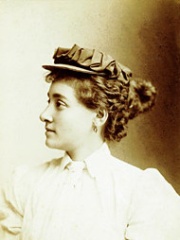


The Most Famous
EXPLORERS from Latvia
Top 3
The following people are considered by Pantheon to be the most legendary Latvian Explorers of all time. This list of famous Latvian Explorers is sorted by HPI (Historical Popularity Index), a metric that aggregates information on a biography's online popularity.

1. Annie Londonderry (1870 - 1947)
With an HPI of 63.24, Annie Londonderry is the most famous Latvian Explorer. Her biography has been translated into 25 different languages on wikipedia.
Annie Cohen Kopchovsky (1870 – 11 November 1947), known as Annie Londonderry, was a Latvian immigrant to the United States who in 1894–95 became the first woman to bicycle around the world. After having completed her travel, albeit mostly by ship, she built a media career around engagement with the popular conception of what it was to be female.

2. Johann Anton Güldenstädt (1745 - 1781)
With an HPI of 63.16, Johann Anton Güldenstädt is the 2nd most famous Latvian Explorer. His biography has been translated into 20 different languages.
Johann Anton Güldenstädt (26 April 1745 in Riga, Latvia – 23 March 1781 in St. Petersburg, Russia) was a Baltic German naturalist and explorer in Russian service. Güldenstädt lost both his parents early, and from 1763 onwards studied pharmacy, botany and natural history in Berlin. At the age of 22, he obtained his doctorate in medicine at the University of Frankfurt in 1767. In the following year, he joined the Russian Imperial Academy of Sciences' expedition sent by Catherine II of Russia to explore the Russian empire's southern frontier. Güldenstädt travelled through Ukraine and the Astrakhan region, as well as the northern Caucasus and Georgia, both of which were almost entirely beyond the borders of the Russian empire. In March 1775 he returned to St Petersburg. The results of the expedition and Güldenstädt's edited expedition journal were published after his death by Peter Simon Pallas in Reisen durch Russland und im Caucasischen Gebürge (Travels in Russia and the Mountains of the Caucasus) (1787–1791). The expedition contributed greatly to the fields of biology, geology, geography, and particularly linguistics. Güldenstädt took detailed notes on the languages of the region. After the expedition, which definitively established Güldenstädt's reputation at the Academy, he continued to work as a naturalist. Güldenstädt's expedition was the first systematic study of the Caucasus. As was typical of contemporary expeditions organized in the spirit of the Enlightenment (including the later American Lewis and Clark Expedition), it was tasked with the observation and description of virtually every aspect of the region under study. This included both its "natural" attributes — flora, fauna, geography, and geology — and its peoples, economy, and government. In this sense it was both a scientific expedition and a mission of reconnaissance to learn more about a region that was important in the simultaneous Russian war with the Ottomans, of which the Caucasus was a theater, with the Georgians acting as Russian allies. Immediately following the expedition, Russian interest in the region, particularly Georgia, grew markedly, culminating in the Treaty of Georgievsk, which made East Georgia a Russian protectorate. In 1781, he died from an outbreak of fever in St. Petersburg.

3. Matvei Gedenshtrom (1780 - 1845)
With an HPI of 57.90, Matvei Gedenshtrom is the 3rd most famous Latvian Explorer. His biography has been translated into 15 different languages.
Mathias or Matthias Hedenström (Swedish; 1780 – 2 October [O.S. 20 September] 1845), also known by his Russian name Matvei Matveyevich Gedenshtrom (Матвей Матвеевич Геденштром), was a Russian explorer of Northern Siberia, writer, and public servant.
People
Pantheon has 3 people classified as Latvian explorers born between 1745 and 1870. Of these 3, none of them are still alive today. The most famous deceased Latvian explorers include Annie Londonderry, Johann Anton Güldenstädt, and Matvei Gedenshtrom.
Deceased Latvian Explorers
Go to all RankingsAnnie Londonderry
1870 - 1947
HPI: 63.24
Johann Anton Güldenstädt
1745 - 1781
HPI: 63.16
Matvei Gedenshtrom
1780 - 1845
HPI: 57.90
Overlapping Lives
Which Explorers were alive at the same time? This visualization shows the lifespans of the 3 most globally memorable Explorers since 1700.

